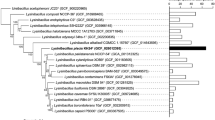Abstract
Lactic acid bacteria have been identified as typical and numerically significant members of the gut microbiota of Reticulitermes flavipes and other wood-feeding lower termites. We found that also in the guts of the higher termites Nasutitermes arborum (wood-feeding), Thoracotermes macrothorax, and Anoplotermes pacificus (both soil-feeding), lactic acid bacteria represent the largest group of culturable carbohydrate-utilizing bacteria (3.6–5.2×104 bacteria per gut; 43%–54% of all colonies). All isolates were coccoid and phenotypically difficult to distinguish, but their enterobacterial repetitive intergenic consensus sequence (ERIC) fingerprint patterns showed a significant genetic diversity. Six different genotypes each were identified among the isolates from R. flavipes and T. macrothorax, and representative strains were selected for further characterization. By 16S rRNA gene sequence analysis, strain RfL6 from R. flavipes was classified as a close relative of Enterococcus faecalis, whereas strain RfLs4 from R. flavipes and strain TmLO5 from T. macrothorax were closely related to Lactococcus lactis. All strains consumed oxygen during growth on glucose and cellobiose; oxygen consumption of these and other isolates from both termite species was due to NADH and pyruvate oxidase activities, but did not result in H2O2 formation. In order to assess the significance of the isolates in the hindgut, denaturing gradient gel electrophoresis was used to compare the fingerprints of 16S rRNA genes in the bacterial community of R. flavipes with those of representative isolates. The major DNA band from the hindgut bacterial community was further separated by bis-benzimide-polyethylene glycol electrophoresis, and the two resulting bands were sequenced. Whereas one sequence belonged to a spirochete, the second sequence was closely related to the sequences of the Lactococcus strains RfLs4 and TmLO5. Apparently, those isolates represent strains of a new Lactococcus species which forms a significant fraction of the complex hindgut community of the lower termite R. flavipes and possibly also of other termites.
Similar content being viewed by others
Author information
Authors and Affiliations
Additional information
Electronic Publication
Rights and permissions
About this article
Cite this article
Bauer, S., Tholen, A., Overmann, J. et al. Characterization of abundance and diversity of lactic acid bacteria in the hindgut of wood- and soil-feeding termites by molecular and culture-dependent techniques. Arch Microbiol 173, 126–137 (2000). https://doi.org/10.1007/s002039900120
Received:
Accepted:
Published:
Issue Date:
DOI: https://doi.org/10.1007/s002039900120




